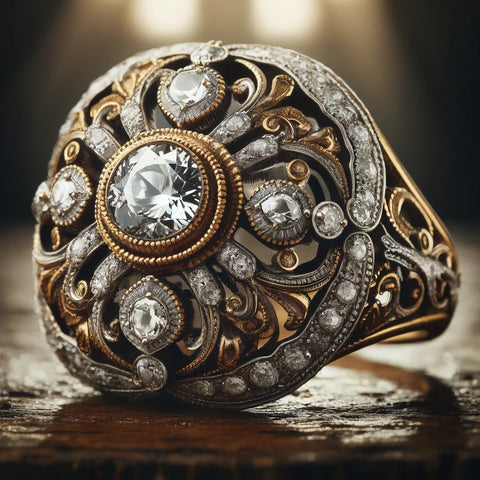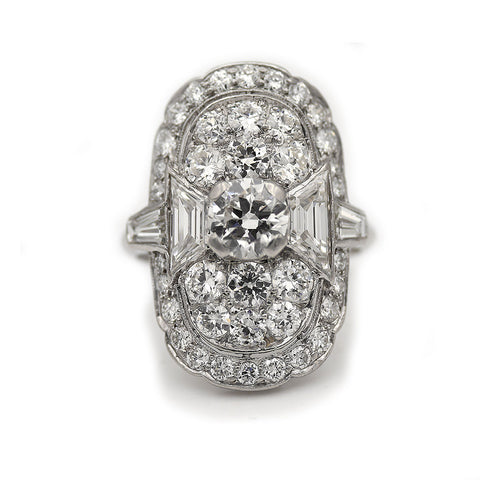What Are The Vintage Jewelry Eras? (2023)
by Suzanne Sachs — 5 min read
THE BASICS --
With the incredible popularity and increased demand for vintage jewelry we've decided to take a look at the various jewelry movements of the past two and a half centuries. The essential elements of jewelry history are comprised of 8 time periods and the wonderful artistry of the past master jewelers. This is when we get most of our jewelry (go further back and it probably belongs in a museum). Here is a list and description of the past jewelry era's we think are of utmost importance.
WHAT YOU NEED TO KNOW--
In this guide, we will explain the following:
- What Are The Jewelry Time Periods?
- Georgian Era
- Victorian Era
- Art Nouveau
- Belle Epoch
- Edwardian
- Art Deco
- Retro
- Mid-century
What Are The Jewelry Time Periods
• Georgian (1760-1837)
The Georgian period is named after the four successive English kings: George I, George II, George III and George IV, and it spans from the second half of 18th century to part of the 19th century. The diamonds in this fashion were primarily of the basic rose and old miner cuts. In addition, we saw a lot of stone settings using a closed back to hide silver foil underneath and give the piece greater—and artificial—brilliance. It is important to note that the Georgian period keeps rising in popularity and continues to be quite rare, no doubt due to the fact that it dates back a few centuries! Unfortunately we currently have no such piece in our collection.
• Victorian (1837-1901)
Jewelry produced during the reign of Queen Victoria of England is fittingly known by the Victorian moniker. Pieces from this period tend to be highly emotional, moving through joy, happiness to sadness and despair effortlessly. It therefore comes as no surprise that mourning rings were a very common occurrence back then. Yellow gold, rose gold, enamel, silver and diamonds were plentiful back then, and the jewelry styles so abundant professionals usually must divide the era into three: early Victorian, mid-Victorian and late Victorian.
• Art Nouveau (1895-1910)
A short era perhaps, but one that must be given special attention. Motifs typical of the time, and currently very much gaining in popularity, were flowers, dragon flies, free flowing lines, birds and pastel colored enamels. It was back then that enamel pins and brooches were first used with gemstones such as amber, agate opals and garnets. As a direct result diamonds also became less popular.
• Belle Epoque (1871-1914)
Overlapping the Edwardian and Victorian era in England and the rest of the English world, this period was their equivalent — though set in France and, to a lesser extent, other Latin countries. We see for the first time the mass addition of platinum and pearls in jewelry, as well as the reintroduction of garlands, foliate motifs, lace and bows that were prevalent during the 18th century French royal court. Workmanship is open, delicate and free.
• Edwardian (1901-1915)
While at the time diamonds once again became popular, this era also saw the use of amethysts, peridots, demantoid garnets, aquamarines, opals and pearls rise tremendously. We tend to see the jewelry of the Edwardian period as light and airy, undoubtedly due to the fact that filigree workmanship gained in popularity with beautiful and intricately detailed designs.
“I've purchased two vintage rings from Suzanne over the past decade and my wife has loved both. Great service, communication and speedy delivery.”
• Art Deco (1915-1938)
Art Deco jewelry can be categorized as bold, sharp and modernistic. For the first time, western jewelers were introduced to such incredible and pure gemstones as Kashmir Sapphires, Burma Rubies and Colombian Muzo emeralds. During that time, platinum also continued its rise in popularity, while geometric shapes, futuristic motifs and the bold combination of colors and abstract patterns became standard. The leading jewelry designing powerhouses of today, such as Cartier and Boucheron, all made their name during this era.
• Retro (1939-1950)
Retro jewelry was produced in the 1940s and early 1950s. When we think of the Retro period we think of old Hollywood and all its glamour. We are introduced to rubies, amethysts, aquamarine, sapphires, diamonds and multi colored precious stones. It is worth noting that clips and brooches became very popular during this time as well.
• Mid Century (1950-1970)
Here we start to see the great return of platinum and diamond. In addition, the big jewelers Winston, Van Cleef & Arpels, Cartier and Tiffany are all suddenly very popular again. Extravagant pieces are created with diamonds, rubies, sapphires, emeralds and pearls. The design itself changes and becomes more open and curved with very feminine motifs. Gaining popularity is also a suite of matching sets on a much grander scale. It is also Hollywood's golden age which is why this period is often referred to as the "Fabulous Fifties."
“My experience with Vintage Diamond Ring was so excellent I really had to think about it for a while. First their selection of jewelry is profound. The quality is superior.”
Vintage Jewelry For Everyone:
No matter which era is your favorite, these time-honored pieces of jewelry have a rich history and individualized character and will continue to have a timeless ;beauty and elegant appeal that is part of a legacy to pass on to future generations.
Find The Perfect Engagement Ring:
Vintage jewelry is prized not only for their beauty but also for it's exquisite attention to detailing and design. If you're looking for a ring with a sense of glamour, sophistication and vintage charm, explore our collection of vintage engagement rings today.
Suzanne Sachs
Suzanne has always believed vintage rings can change lives. She's been in the jewelry industry for over 35 years, working with vintage jewelers, diamond dealers, diamond cutters, and gemologists. Suzanne started Artdecodiamonds in 2000 and understood the demand for vintage rings throughout the world. She ultimately started VintageDiamondRing.com in 2014, and understands each vintage ring is a reflection of you – your history, your relationships, your style, your elegance and is honored to have the opportunity to help you showcase your flair in a unique and exquisite way.
Contact Suzanne
If you love vintage or eco-friendly jewelry please feel free to contact Suzanne or browse our collection of eco-friendly vintage engagement rings.















Leave a comment